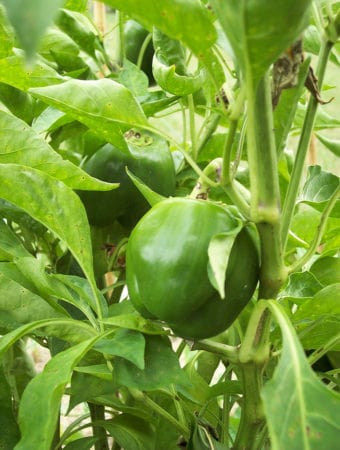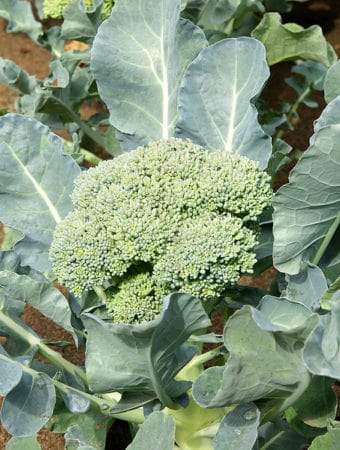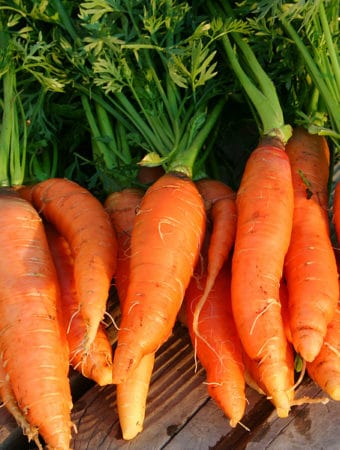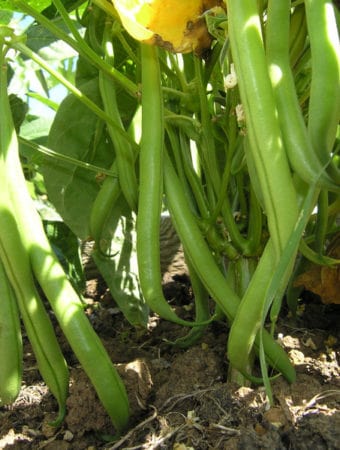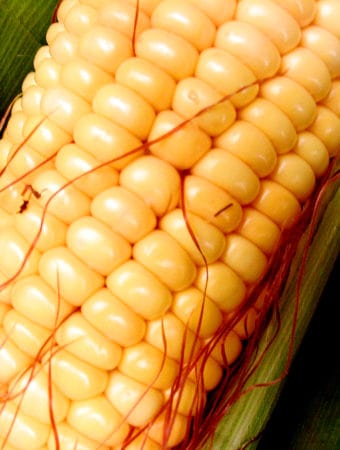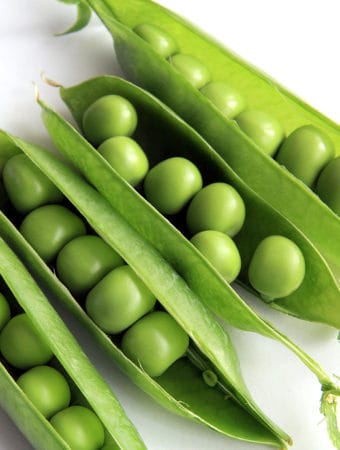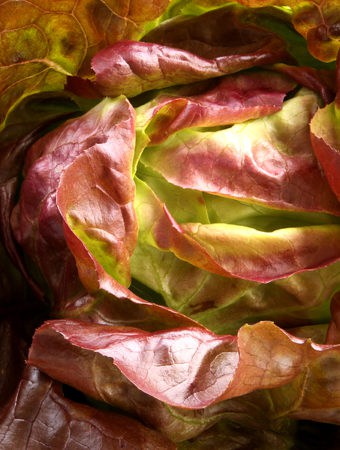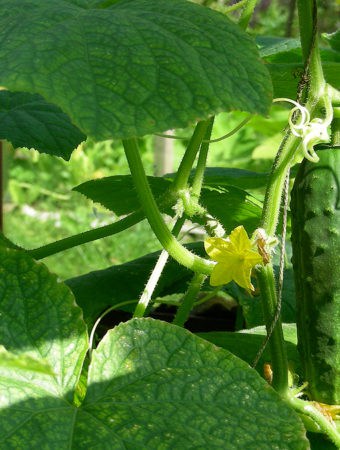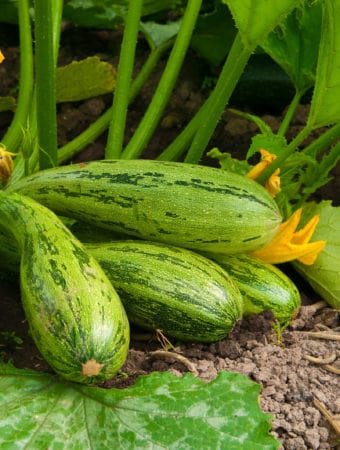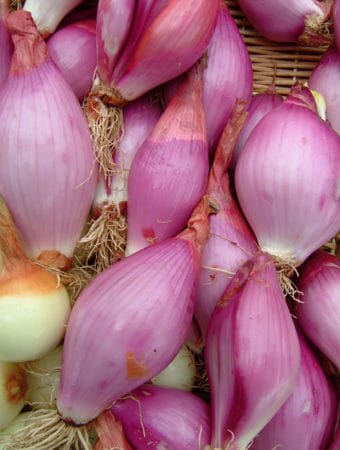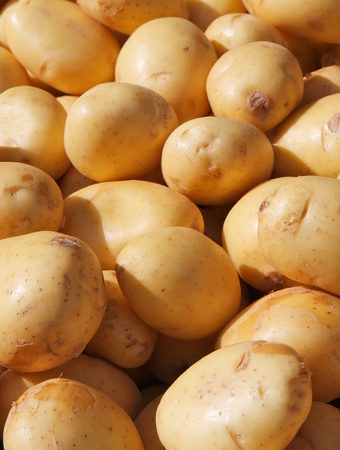Sweet corn is a warm-season annual. It is one of the most popular home garden crops and one of the most widely planted commercial crops. Sweet corn is grown for its juicy, plump, sweet-flavored kernels. Corn can be eaten steamed, boiled, or roasted.
Grow corn in the warm time of the year. Direct sow corn after all danger of frost has passed. Make succession sowings for a continuous harvest throughout the growing season.
Related articles:
- Seven Ways to Cook and Serve Sweet Corn
- How to Make Sweet Corn Soup
- Sweet Corn Seed Starting Tips
- How to Harvest and Store Sweet Corn
- Corn Growing Problems Troubleshooting
- How to Plant and Grow Sweet Corn
- Corn Earworm Organic Pest Control
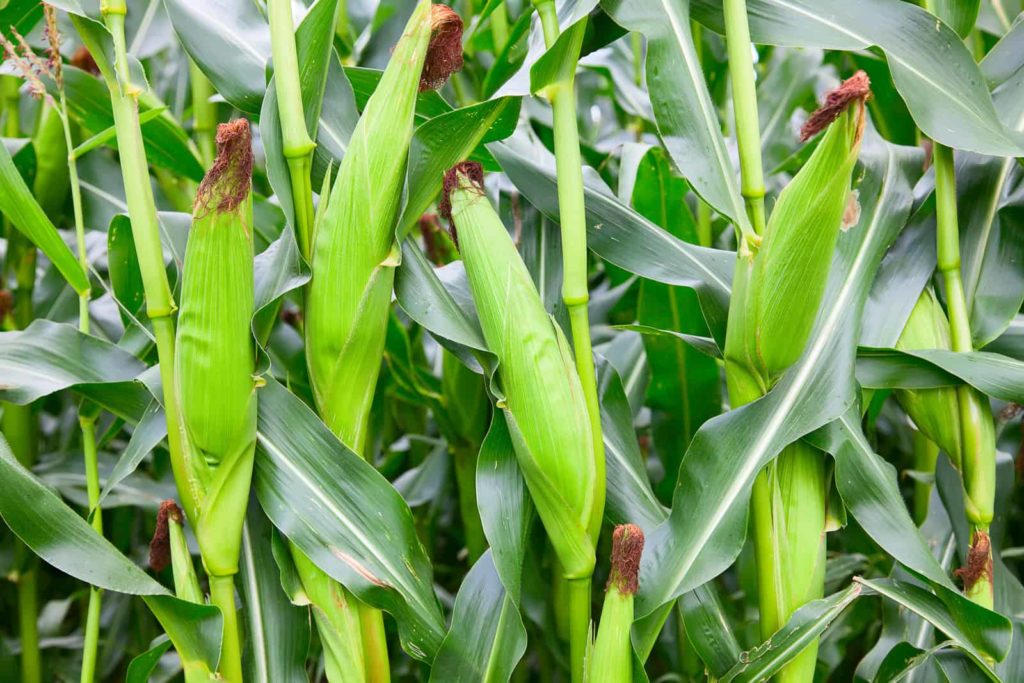
Sow or plant corn directly in the garden two weeks after all danger of frost is past and the soil has warmed to 60°F. In cool regions and where cool weather persists, spread black plastic on the planting area to speed ground warming, or sow seed in sun-warmed ridges about 3 inches above the planting bed. Protect young seedlings from chilly nights with a floating row cover.
Good Products for Growing Corn at Amazon:
- Garden Safe Snail and Slug Bait
- Bonide Sulfur Fungicide
- Monterey BT Caterpillar Killer
- Neem Bliss 100-% Cold Pressed Neem Oil
- Safer Brand Insect Killing Soap
- PyGanic Botanical Insecticide
Corn can be started indoors in peat pots to avoid disturbing the roots at transplanting time. Seeds germinate at 50°F. Seedlings should go into the garden within a couple of weeks of emergence; this is important to avoid a check in growth. Time indoor sowing so that corn goes into the garden when the outdoor temperatures are very warm; corn loves heat.
In addition to sweet corn, other types of corn include popcorn, flint corn, and flour corn; flint corn is (Zea mays var. indurata; also known as Indian corn or sometimes calico corn is used in ornamental decorations); flour corn (Zea mays var. amylacea) is a variety of corn with a soft starchy endosperm and a thin pericarp; Zea mays everta, is the only type of corn to actually pop.
Sweet corn is a summer crop. It is best planted in late spring after the soil temperature reaches 60°F (16°C), usually two or three weeks after the last frost in spring. Corn planted out of season in cold, wet soil is unlikely to germinate.
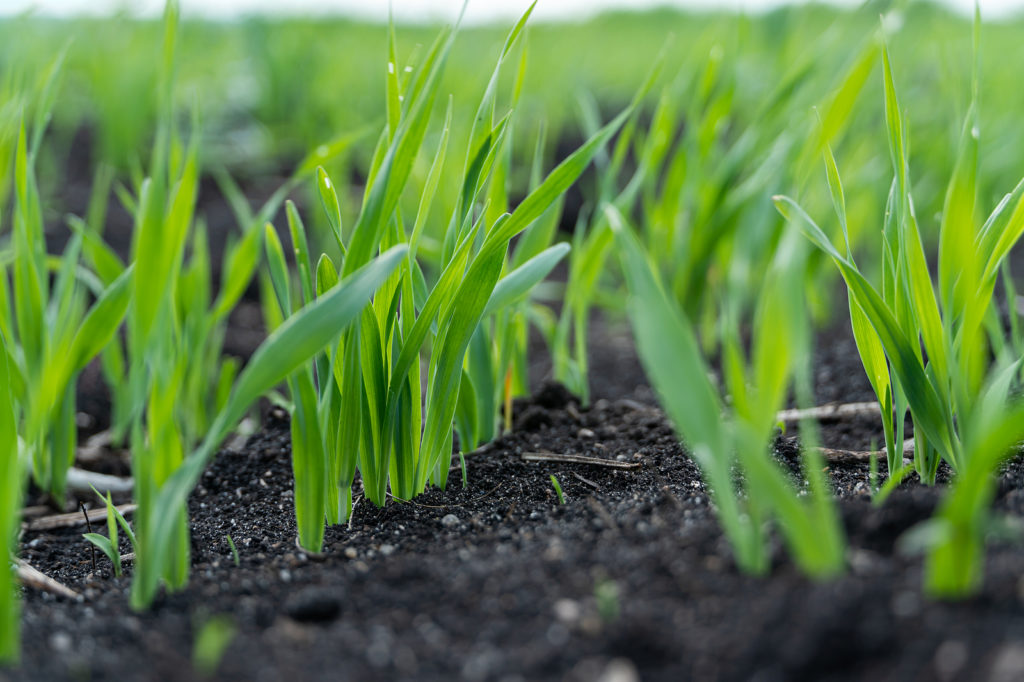
Here is your complete guide to growing sweet corn!
Three types of sweet corn
Corn growing starts with deciding which type of corn to plant: standard, sugar-enhanced, or super-sweet.
- Standard sweet corn varieties (sometimes called “normal sugar”) have old-time “corny” flavor. ‘Golden Bantam’ is a classic yellow-kernel standard sweet corn, also ‘Country Gentleman’ (white kernels), ‘Silver Queen’ (white) and ‘Double Standard’, and ‘Honey and Cream’ (both bi-color kernels).
- Sugar-enhanced corn cultivars are sweeter and tenderer than standard varieties. ‘Bodacious’, ‘Early Choice’, and ‘Kandy Korn’ are yellow kernel sugar-enhanced cultivars. ‘Platinum Lady’ and ‘Alpine’ have white kernels. ‘Gold ‘N Pearl’. ‘D’Artagnan’, and ‘Peaches and Cream’ are sugar-enhanced bi-colors.
- Super-sweet corn cultivars are the sweetest of all but can lack flavor and tenderness. Yellow kernel super-sweet cultivars include ‘Illini Xtra-Sweet’ and ‘Krispy King.’ ‘How Sweet It Is’, ‘Sugarburst’, and ‘Aspen’ are white kernelled. ‘Honey ‘N Pearl’ and ‘Skyline’ are bicolor.
Sweet corn quick growing guide
- Corn grows best in air temperatures from 60° to 95°F (16-35°C).
- Corn requires 6 to 8 hours of direct sun each day.
- Corn can take from 60 to 100 days to reach harvest depending upon variety and the amount of heat during the growing season.
- Corn is a tender annual and a member of the grass family that can grow from 4 to 12 feet (1.2-3.6m) tall.
- One to two ears of corn form on the side of each tall, green, grass-like stalk.
- Flowering tassels form at the top of each stalk; pollen falls from the tassels onto silky threads growing from each ear below. Each silk is connected to an unfertilized kernel.
- Each ear of corn forms as many kernels as the number of silks that were pollinated. (Tassels are the male flowers of the corn plant. Kernels and ears are the female flowers.)
- Kernels of sweet corn can be yellow, white, black, red, or a combination of colors.
- A large corn variety may form one or two harvestable ears on each stalk.
- A dwarf variety may form two or three harvestable ears per stalk. When pollination does not occur the stalk will produce only a cob.
See Garden Products Recommended by Harvest to Table
Corn Yield. Plant 12 to 20 corn plants per household member.
Where to plant sweet corn
Choose a site with full sun. Choose a bed or site where corn can be planted on 2 to 3-foot squares or blocks. Planting in a block pattern will maximize pollination: corn is pollinated commonly by the wind as the pollen falls from the male tassels to the female silks. Even close proximity of stalks will enhance the opportunity for pollination.
- Plant corn in full sun.
- Corn grows best in loose, well-worked, well-drained soil with a pH of 5.8 to 6.8. Adjust the soil pH if necessary before planting.
- Add aged compost or aged manure to the top 8 to 10 inches of the planting bed before planting corn or add aged compost to the planting area in the autumn before planting.
- Adding plenty of organic matter to the planting area will ensure good drainage. Rich soil–that is soil rich in organic matter–will also ensure rapid growth.
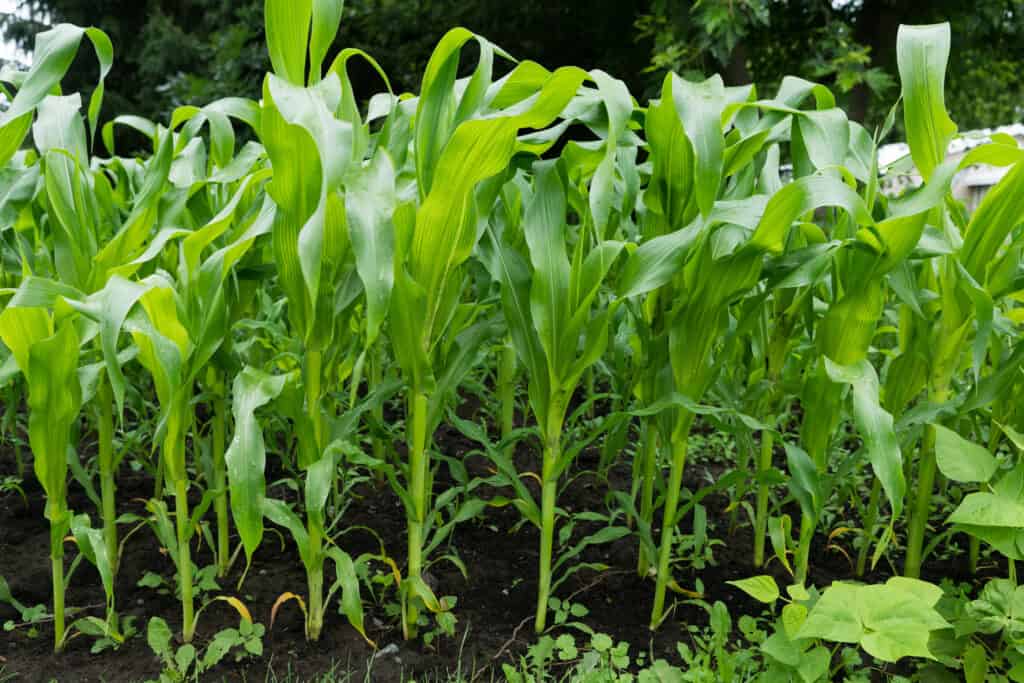
Sweet corn planting time
Sow corn or set out small starts when the soil has warmed to at least 65°F, usually two to three weeks after the last frost in spring. Black plastic can be used to cover the soil in advance and prewarm the bed.
- Corn is a tender, warm-season annual that is best planted after the soil temperature reaches 60°F (16°C), usually 2 or 3 weeks after the last frost in spring. Corn will germinate in soil as cool as 50°F but germination will be delayed.
- Corn requires 60 to 100 frost-free days to reach harvest depending upon variety and the amount of heat during the growing season.
- Corn grows best in air temperatures from 60° to 95°F ((16-35°C).
- Corn seed germinates in 10 to 14 days at 75°F (24°C), but the rate of germination may reach only 75 percent.
- Corn planted in cold, wet soil is unlikely to germinate.
- Outdoor corn seed sowing can begin 3 weeks after the last frost in spring. Check seed packet for the cold tolerance of the variety you want to grow.
- Start corn indoors 2 to 3 weeks before the last frost in spring for transplanting 2 to 3 weeks after the last frost. If your season is long enough, plant successive crops every two to three weeks. Place seed trays or pot on a seed starting heating mat and under a grow light.
See Garden Products Recommended by Harvest to Table
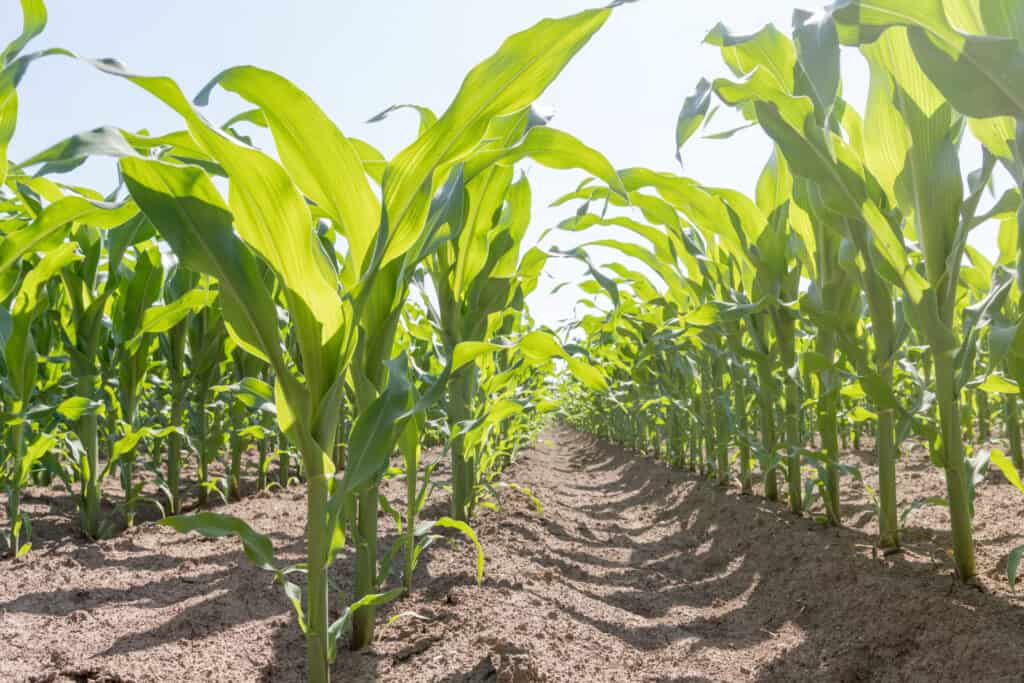
Planting and spacing sweet corn
Sow corn seeds 1 inch deep; after the weather has grown hot in mid-summer, sow corn 3 to 4 inches deep. Set seed 2 to 3 inches apart in rows; space rows 30 to 36 inches apart. (Closer spacing will result in smaller ears at harvest.) Make successive sowings every 2 to 3 weeks for a continuous harvest summer into fall or plant early, midseason, and late varieties at the same time.
Plant corn on small hills or in raised beds; corn prefers well-drained soil that warms quickly. In flat beds, turn the soil to 6 inches deep. Add plenty of aged compost to the planting area and dust with nitrogen-rich cottonseed meal or soybean meal (3 pounds per 100 square feet).
- Sow corn 1 to 1½ inches (2.5cm) deep. Sow pathogen-free seed.
- Plant seeds 2 to 4 inches (5-10cm) apart in short, side-by-side rows to form a block, rather than one long row. A square block of plants with 10 or more plants in each row is best for to ensure pollination. A square block of corn plants is often called a corn patch.
- You can also grow several plants on mounds or inverted hills.
- Planting in a block or clump will help ensure pollination.
- Thin plants from 12 to 18 inches (30-45cm) apart for short varieties and 18 to 24 inches (45-61cm) apart for tall varieties once plants are 4 to 6 inches (10-15cm) tall.
- Corn planted too closely will require more water and fertilizer and may offer a smaller yield.
- For a continuous harvest, succession plant corn every two weeks or plant early, midseason, and late varieties at the same time.
- Sweet corn seed is viable for 1 to 3 years if stored in a dry, airtight container.
More tips: Corn Seed Starting Tips.
Sweet corn pollination
Corn is wind-pollinated. The male flower is the tassel; it forms at the top of the cornstalk and produces pollen. The female flower is the silk; silks are fine strands that emerge from the husks that cover each ear of corn lower on the plant. Every potential corn kernel is connected to a silk.
Pollen must drop or be blown from the tassels onto the silks for plump kernels to develop. When there are gaps in an ear of corn, that means a silk or silks were not pollinated.
Corn is wind-pollinated (and easily cross-pollinates). Planting corn in short blocks of 3 to 4 rows rather than a single row will aid wind pollination and increase yield. To avoid cross-pollination, plant different corn varieties at least 100 or more feet apart or plant so they tassel two weeks apart. (A corn stalk is topped by a flowering tassel that produces pollen. The wind carries the pollen to silky threads on the ears a quarter of the way down the stalk. Each silk is connected to an unfertilized kernel. The number of kernels in an ear is the same as the number of silks that were pollinated.)
When tassels appear on the ears, gently shake stalks each day so that pollen will fall to the silks. Differing corn varieties planted in close proximity will likely result in cross-pollination.
Planting corn in blocks to increase pollination
Corn pollination is more apt to happen in a home garden when corn is planted in blocks of four to six short rows instead of one or two long, single-file rows.
To increase successful corn pollination, plant corn in a patch at least four feet by four feet. Space plants six to eight inches apart, in rows about 18 to 24 inches apart. When the plants grow tall and form tassels and silks, a gentle breeze (or a rustle of your hands) will ensure pollen falls from tassels to silks (and not to the ground).
An alternative to planting corn in short rows is to plant corn in hills set in block or square formations. Plant three or four stalks per hill and set hills about three feet apart.
Hand pollinating corn
To give Mother Nature a hand, you can hand-pollinate the silks. When silks emerge from ears of corn, head out to the corn patch and shake the tassel on each stalk on a daily basis for several days. This will ensure that pollen drops from the tassels to the silks below.
For successive harvests throughout the growing season, sow new blocks of corn plants every two weeks. Planting two weeks apart is particularly important if you are growing more than one variety of corn.
Corn cross-pollination
Corn plants easily cross-pollinate and cross-pollination of different varieties can result in corn that is less tasty. By planting differing varieties two weeks apart, the tassel formation of the second variety will not occur at the time the first is in silk.
Watering sweet corn
Corn is a member of the grass family; it requires regular even moisture. Give corn 1 to 2 inches of water each week. Place drip irrigation or a soaker hose near the base of stalks and cover with straw mulch to help keep the soil evenly moist.
- Keep corn evenly moist and regularly watered.
- One inch of water per week (6 gallons per square yard) in average summer weather; more in very hot weather.
- Corn grows fast in hot weather and requires an even supply of moisture to avoid wilting.
- Avoid overhead watering particularly when tassels appear; water hitting the tassels at the time of pollination can reduce the number of kernels on a cob.
- Water-stressed corn will produce ears with missing kernels.
- Use the finger test to know if you should water: stick your index finger into the soil, if it comes away dry, it’s time to water.
Fertilizing sweet corn
Corn is a heavy feeder. Place a band of aged compost in a furrow two inches from where you are going to sow the seed and an inch deeper than the seed level. Feed corn with a high-nitrogen fertilizer or side-dress with aged compost when stalks are 8 inches high and again when they are 18 to 24 inches high. Corn will grow particularly well where nitrogen-setting beans and legumes have grown the season before. In the winter before planting corn, add aged manure and compost into the planting bed and work it into the soil with a garden fork. Side-dress corn with aged compost every 3 to 4 weeks during the growing season.
- Add aged compost and aged manure to planting areas in the autumn before planting.
- Corn is a heavy feeder; it needs plenty of nitrogen user.
- Side dress corn with aged compost or compost tea when stalks are 10 inches tall and again when they are 18 inches tall and a third time when they tassel.
- You can also side dress corn with nitrogen-rich blood meal, feather meal, aged chicken manure, alfalfa meal, or cottonseed meal.
- Add “green manure’ such as clover or vetch into the crop rotation for areas where you plan to plant corn.
Sweet corn companion plants
- Good companions for corn are potatoes, peas, beans, cucumbers, pumpkins, and squash.
- Do not plant corn with berries or pole beans.
Sweet corn care
Corn is shallow-rooted; competing weeds can rob corn of nutrients and moisture. Keep weeds out of the corn patch, especially during the first month of growth. After that, control weeds by applying a thick mulch of compost. A cover crop of nitrogen-setting clover planted a month after corn is planted will also keep weeds down.
- Weed corn early to avoid competition for water and nutrients. Corn is shallow-rooted so avoid deep cultivation.
- Crowding stimulates lots of silage, but no cobs.
- To protect corn from birds cover ears with paper bags after pollination.
- Poor kernel development can be the result of poor pollination, too few plants resulting in poor pollination, overcrowding, or a potassium deficiency in the soil.
- If stalks are purple looking there is likely a phosphorus deficiency.
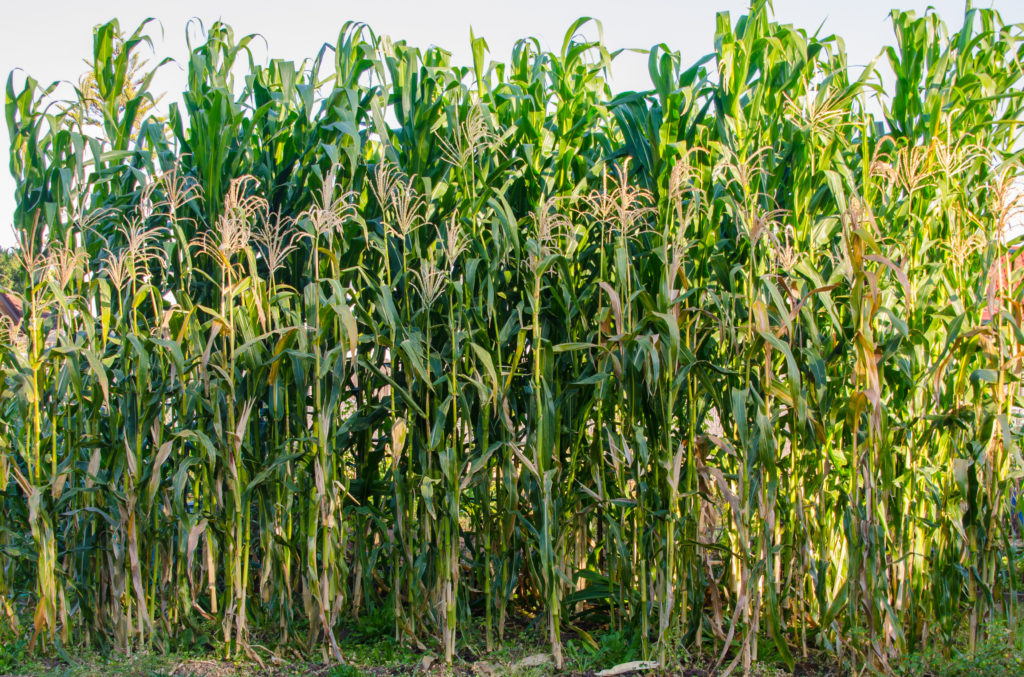
Lodging corn
If maturing corn stalks begin to fall over (called “lodging”), simply straighten them up and pack some soil around the roots and crown of the plant. Hilling corn early in the season may prevent lodging: use a hoe to draw up soil around the stalks as they mature.
See Garden Products Recommended by Harvest to Table
Container-growing sweet corn
- Corn can be grown in a large container but is not a practical choice for container growing because pollination requires several plants.
- Plant 5 or 6 seeds in a large five-gallon container.
Sweet corn pests
Cover seeded beds with row cover to exclude birds, caterpillars, and beetles early on. Handpick caterpillars and beetles that attack mature plants. Apply 5 drops of vegetable oil to the silks on each ear as the silks begin to brown; this will turn away earworms.
- Corn can be is attacked by cutworms, wireworms, flea beetles, corn earworms, and corn borers. Look for pests and handpick and destroy them.
- Corn earworms are moth larvae. Moth eggs hatch on developing silks; later the small caterpillars will follow the silks down into the ears, where they feed on the tips. Place a drop of mineral oil inside the tip of each ear to coat and suffocate earworms.
- Corn stalk borers–European corn borers–are purple and white moth larvae that will tunnel into stalks and ears to begin feeding. Handpicking is the best control. Keep the garden free of debris where borers and earworms can live. Use row covers to exclude beetles.
- Corn flea beetles are tiny black beetles an eighth of an inch long that transmit Stewart’s wilt; they chew leaves. Use floating row covers to exclude corn flea beetles.
- Armyworms are striped moth larvae that feed on corn foliage, especially in spring. Remove armyworm by hand to spray with Bacillus thuringiensis (Bt), an organic moth larvae control.
- Corn leaf aphids are blue-green sap-sucking insects that attack corn foliage. Aphids can disrupt pollination and stunt plant growth; a sharp blast of water will knock them from plants; beneficial insects such as lady beetles, green lacewings, and syrphid flies will eat aphids.
- Corn rootworms are cream-colored beetle larvae less than a half inch long; the adult beetles eat corn silks; pick beetles off by hand.
- Cutworms feed on roots and stems of corn seedlings; these pests live in the soil near plants; overturn the soil to uncover them; use paper collars to protect seedling stems from cutworms.
- Flea beetles are tiny black and bronze leaf beetles 3/8 inch long that will chew on leaves; exclude flea beetles by covering young plants with row covers.
- Japanese beetles are metallic copper with green insects that will chew corn silks; larvae are white grubs that grow to an inch long; control with Bacillus thuringiensis (Bt) or by hand picking.
- Seedcorn maggots are white fly larvae a quarter inch long; they feed on seeds especially in cooler, wet weather. Turn the soil before planting to expose larvae to the cold.
- Slugs can defoliate young plants; use an iron phosphate bait to kill these pests.
- Wireworms are click beetle larvae about a half to 3 inches long; turn the soil ahead of planting to expose these pests to killing cold temperatures.
- Raccoons and many rodents will also attack corn. Use traps or fences to exclude these pests.
Sweet corn diseases
- Corn is susceptible to smut, a fungus disease, and Stewart’s wilt, a bacterial disease. Corn smut will turn kernels gray or black and cause kernels to swell. Destroy affected plants, and do not replant in the same place for two years. Smut spores can survive in the soil for two years.
- Stewart’s wilt is a bacterial disease spread by flea beetles. Stewart’s wilt will cause leaves to yellow and plants to become stunted. Plant disease-resistant varieties and control flea beetles by placing wood ash or agricultural lime around plants.
- Corn is also susceptible to Anthracnose, rust, leaf spot, and leaf blight. Crop rotation is the best way to avoid the spread of pathogen diseases; avoid planting corn in the same spot every year; a four-year crop rotation is best.
More help with corn problems: Corn Growing Problems: Troubleshooting.
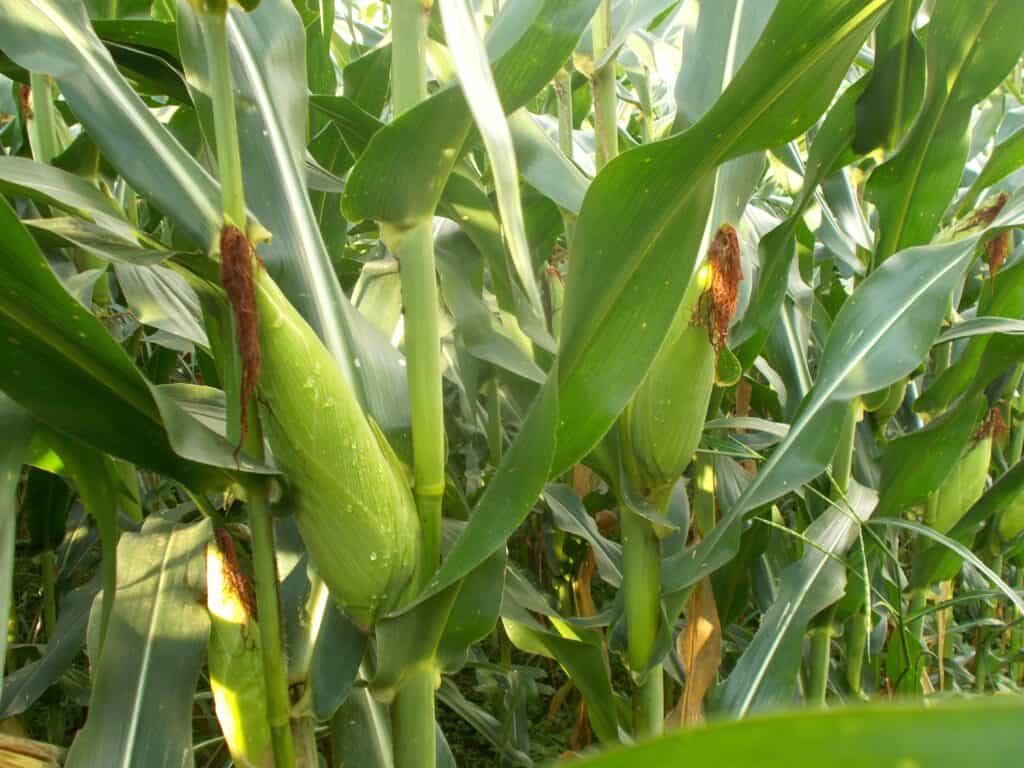
Sweet corn harvest
Harvest is near when ears are plump and silks have withered, about three weeks after the silks appear. To know when to pick corn–apart from ears being plump, pull back part of the husk and pierce a kernel with your thumbnail. If there a milky juice spurts out, the sweet corn is ripe. (If the juice is watery, the corn is immature. If the juice is pasty, the corn is past its prime.) Corn is at the peak of sweetness for two to five days.
Begin picking ears 3 weeks after the first silks appeared on stalks. When silks turn brown, check ears to make sure they are filled and begin picking. You can also squeeze a kernel with your fingernail: if white milky juice drips out, the ear is ripe. Popcorn should be left on the plant until the husks have fully dried.
• Corn Yield. Corn will yield 1 to 2 ears per plant, about 10 to 12 ears per 10-foot row. Plant 10 to 15 plants per person.
- Corn requires from 60 to 100 days to reach harvest depending on the variety and warm weather. A corn plant typically produces two ears per stalk; some varieties are higher yielding.
- Corn is ready for harvest when yellow silks turn dark brown, and kernels are soft and plump; squeeze a kernel with your fingernail– if the juice is milky, not clear, the ear is ready for picking.
- Harvest usually comes about 20 days after the silks appear.
- Pick corn by grabbing the ear and giving it a sharp downward twist.
- Each stalk of corn will produce one or perhaps two harvestable ears of corn.
- Harvest corn in the morning when the kernels are full of moisture and plunge ears immediately into cold water to preserve sweetness.
- Harvest flint corn just before the first frost.
- Harvest popcorn and flour corn when the kernels are hard and glossy.
See Garden Products Recommended by Harvest to Table
Storing and preserving sweet corn
- Corn is best eaten fresh.
- Keep sweet corn in their husks until ready to cook.
- Corn will keep in the refrigerator for 2 to 4 days; wrap the unopened husk in damp paper towels.
- Blanched corn on the cob can be frozen for 3 to 6 months.
- Store flint corn, flour corn, and popcorn in a dry place. Peel back the husk and hand the ears to allow the kernels to dry further.
Sweet corn kitchen use
- Sweet corn is served cooked either on or off the cob.
- Kernels can be removed from the cob before or after cooking. Remove kernels with a sharp knife.
- Sweet corn can be steamed, boiled, or roasted. Husks can remain on corn ears when they are roasted.
- Raw kernels can be added to soups, mixed with vegetables, stews, and relishes.
- Cooked kernels can be added to salads, omelets, pasta, risotto, salsa, soups or added to a vegetable medley.
- Uncooked kernels can be frozen or canned.
- Flint corn (Zea mays var. indurata; also known as Indian corn or sometimes calico corn) is used to make hominy.orn is used in ornamental decorations.
- Flour corn (Zea mays var. amylacea) is a variety of corn with a soft starchy endosperm and a thin pericarp used to make flour.
Sweet corn varieties
Flavor and adaptability to your garden’s climate are the major considerations when choosing a corn variety. There are three types of fresh-eating sweet corn grouped by flavor: standard corn, sugary enhanced corn, and supersweet corn (adaptability to your garden’s climate–the soil and air temperature–is actually linked to the flavor type). Here’s how these corn types differ:
• Standard corn is the “old-fashioned” corn your grandfather grew; the corn with tasty corn flavor. These varieties–many are heirlooms and open-pollinated–have been around for years and years. Standard corn is plantable in cool soil, as cool as 55°F. This corn is best rushed to the kitchen and eaten within an hour of harvest.
• Sugary-enhanced corn are hybrid varieties that keep their sweet flavor up to 3 days after harvest. Sugary-enhanced hybrids give growers a 3-day window for harvest. (Near harvest time it is important to monitor standard corn each day to make sure you pick at the peak of its sweet flavor.) Sugary-enhanced cultivars don’t require daily monitoring; pick sugary-enhanced corn anytime within the 3-day peak flavor period. This type of corn demands soil temperatures about 10° warmer than standard corn.
• Supersweet corn are also hybrid varieties–the sweetest flavored of all corn. Supersweet corn varieties are sweeter than sugary-enhanced varieties. Supersweets also have an enhanced harvest window of 2 to 3 days. One note, supersweet corn can be demanding: it requires soil no less than 65°F at planting time; it grows best when the soil is pre-warmed (cover beds with black plastic to warm the soil); and it is less vigorous than standard or sugary enhanced corn.
In addition to the best bets of these three types, also listed here are recommendations for popping, baby corn, and ornamental corn. Keep reading to the bottom of this post and I will give you my tips for sure-fired corn growing success.
Standard corn varieties
- Butter and Sugar. 73 days. Bicolor white and yellow kernels, good flavor; 7 to 8-inch ears. Resists bacterial wilt and southern corn leaf blight.
- Golden Cross Bantam. 85 days. Large yellow kernels. Uniform ears are 7½ to 8 inches long with 10 to 14 rows per ear. Sturdy stalk to 6 feet; very prolific. Resists bacterial wilt.
- Jubilee. 83 days. Sweet, tender, yellow kernels for fresh eating or processing. Large ears, 8 to 9 inches long with 16 rows. Strong sturdy stalks from 7 to 7½ feet. Resists smog and smut.
- Silver Queen. 88 days. Very sweet, tender, snow-white kernels; ears 8 to 9 inches long with 14 to 16 rows. Holds for several days without losing quality. Stalk grows 7½ to 8 feet tall. Widely adapted. Resists bacterial wilt and Stewart’s wilt.
Sugary-enhanced corn varieties
- Breeder’s Choice. 73 days. Extra sweet, tender, creamy, light yellow kernels. Stays sweet for 10 to 14 days after reaching maturity. Most stalks bear two ears, 16 to 18 full rows. Plant to 7 feet.
- Concord (Also called Moore’s Early Concord). Tender, sweet, bicolor kernels. Ears 6 to 8 inches long with 12 to 16 rows. Stalks to 5 feet. Early harvest.
- How Sweet It Is. 87 days. Sweet, tender, crisp, white kernels. Flavor holds well on stalks and in storage. Slightly tapered ears to 8 inches long with 18 to 22 rows of kernels. Stalks to 6½ feet tall produce 2 ears per stalk. Widely adapted. All-America selection; resists most diseases.
- Kandy Korn. 89 days. Sweet, tender, golden-yellow kernels. Excellent for freezing and canning. Uniform ears to 8 inches long with 16 to 18 rows. Stalks 8 to 9 feet tall. Adapts to a wide range of climates.
Supersweet corn varieties
- Early Xtra Sweet. 71 days. Extra sweet golden yellow kernels, small and tender. Uniform ears, 7 to 9 inches long with 12 to 16 rows of kernels. Vigorous plant, 5 to 6 feet tall. Ready 2 weeks earlier than Illini Xtra-Sweet. All-America selection; resists most diseases.
- Butterfruit Original Early. 72 days. Bright yellow kernels, savory flavor; tightly packed ears. Plant to 5 feet tall. Mature extra early.
- Sweetie. 82 days. Exceptionally sweet, tender-crisp, deep golden yellow kernels. Slightly tapered ears 7 to 8 inches long with 14 to 18 rows of kernels. Stalks to 6 feet. Retains sweetness for a long period, both in the field and when harvested. 30 percent fewer calories than regular corn. Excellent for home gardens.
- Illini Xtra Sweet. 85 days. Sweet, golden-yellow kernels; 14 to 18 rows per ear. Plant to 6½ feet. Freezes well.
- Super-sweet Jubilee. 85 days. Super sweet, yellow kernels, 18 rows per ear. Plants to 8 feet. High yield.
Baby corn varieties
- Baby Asian. Finger-size cobs with white kernels. Tender and delicately flavored. Use in stir-fries, vegetable salads, and pickles. Harvest shortly after silks appear.
Popcorn varieties
- Black Popcorn. 100 days. Deep blue to black kernels that pop white with a blue tinge at the base; rich flavor. Larger ears and kernels than standard popcorn.
- Gold Hybrid Popcorn. 105 days. Excellent quality popping corn; pops large.
- Peppy Hybrid. 90 days. Kernels pop large and tender. Small ears to 4 inches long. Stalks grow 5 to 6 feet tall; high yielding, 2 or 3 ears per stalk.
- White Cloud. 95 days. Tender, fluffy white, hull-less popping corn with excellent flavor. Small plump ears to about 4 inches long, well-filled. High yield. Grows well in cooler regions.
Ornamental corn varieties
- Indian Corn. 100-110 days. Large, decorative ears: 7 to 9 inches long, kernels of red, purple, orange, yellow, white, and blue. Strong stalks.
- Indian Fingers. 110 days. Multicolored kernels: yellow, red, purple, and orange kernels; cobs to 4 inches long; stalks from 6 to 7 feet.
- Rainbow. 90-112 days. Multicolored kernels. Indian corn. Large, smooth ears. Use for fall decorations, roasting, or frying when young. Open-pollinated.
- Strawberry Popcorn. 105 days. Cobs 2 to 3 inches long with ruby kernels resemble strawberries; plants grow to 4 feet tall. For popping or decoration. Kernels turn white when popped.
Corn varieties by harvest time
- Early season, yellow corn: ‘Bodacious’ (75 days); ‘Earlivee’ (69 days); ‘Early Sunglow’ (63 days); ‘IlliniChief’ (75 days); ‘Sugar Buns’ (72 days); ‘Tuxedo’ (74 days).
- Midseason, yellow corn: ‘Golden Bantam’ (83 days); ‘Golden Cross Bantam’ (90 days).
- Late season, yellow corn: ‘Kandy Korn’ (89 days)
- Early season, white corn: ‘Platinum Lady’ (85 days); ‘Sugar Snow’ (68 days)
- Midseason, white corn: ‘Alpine’ (79 days); ‘Argent’ (82 days); ‘Divinity’ (75 days); ‘Pristine’ (79 days)
- Late season, white corn: ‘How Sweet It Is’ (87 days); ‘Silver Queen’ (94 days); ‘Stowell’s Evergreen’ (100 days)
- Early season, bi-colored corn: ‘Athos’ (67 days); ‘Double Gem’ (75 days); ‘Quickie’ (65 days); ‘Skyline’ (73 days); ‘Sugar and Gold’ (67 days)
- Midseason, bi-colored corn: ‘Butter and Sugar’ (73 days); ‘Clockwork’ (78 days); ‘Honey and Cream’ (78 days);
- Late season, bi-colored corn: ‘Pilot’ (90 days).
- Space-saving varieties: ‘Baby Corn’ (65 days); ‘Golden Midget’ (65 days).
Recommended varieties
- ‘Avalon’ bears tender white kernels on ears to 8 inches long; resistant to northern corn leaf blight, southern corn leaf blight, and southwestern corn leaf blight; matures in 82 days.
- ‘Big N’ Tender’ bears a mix of white and yellow kernels on ears to 8 inches long; resistant to northern corn leaf blight and Stewart’s wilt; mature in 79 days.
- ‘Cafe’ tender yellow kernels on ears to 8 inches long; fast-growing; a good choice for early planting in cool soil; resists Stewart’s wilt and rust; mature in 68 days.
- ‘Calico’ heirloom flint corn with yellow, brown, white, purple, red, and blue kernels to 6 inches long; use as ornamental corn; matures in about 100 to 105 days.
- ‘Dakota Black’ open-pollinated variety with dark red kernels on ears to 7 inches long; use as ornamental or for popping; matures in 95 days.
- ‘Jerry Peterson Blue’ open-pollinated flour corn; make blue flour; ears grow to 8 inches long; matures in 105 days.
- ‘Glass Gem’ open-pollinated flint corn; kernels are various colors on ears grow to 8 inches long; use as ornamental or for making cornmeal or popping; matures in 110 to 120 days.
- ‘My Fair Lady’ sweet corn with white and yellow kernels on ears that grow to 8 inches long; mature in 78 days.
- ‘Solstice’ bicolor sweet corn; resistant to northern corn leaf blight; matures in 68 days.
- ‘Sugar Buns’ sugar-enhanced sweet corn with creamy yellow kernels on ears to 7 inches long; resistant to northern corn leaf blight and Stewart’s wilt; 70 to 80 days to maturity.
More about sweet corn
- Common name. Corn, sweet corn, maize
- Botanical name. Zea mays subsp. mays (sweet corn)
- Family: Poaceae (grass family)
- Origin. Central America
- Types of corn: sweet corn, popcorn, flint corn, flour corn; flint corn is (Zea mays var. indurata; also known as Indian corn or sometimes calico corn is used in ornamental decorations); flour corn (Zea mays var. amylacea) is a variety of corn with a soft starchy endosperm and a thin pericarp; Zea mays everta, is the only type of corn to actually pop.
- Corn is the most widely planted crop in the United States and much of the world.
- Corn that is picked fresh when kernels are plump and juicy is a vegetable. Corn that is picked when kernels are hard and dry is considered a grain.
Corn articles at Harvest to Table:
How to Plant and Grow Sweet Corn
How to Harvest and Store Sweet Corn
Seven Ways to Cook and Serve Sweet Corn
Corn Chowder and Summer Flavors
Grilled Corn with Seasoned Butter
Baby Corn Cooking and Serving Tips
Corn, Beans, Squash: The Three Sisters
Corn Growing Problems Troubleshooting
Corn Earworm Organic Pest Control
More how to grow articles:
Learn how to plant, grow, and harvest your favorite vegetables. Click below for all you need to know.
- Artichoke
- Arugula
- Asparagus
- Beans, Snap
- Beets
- Broad Beans
- Broccoli
- Brussels Sprouts
- Cabbage
- Cantaloupe — Melons
- Cardoon
- Carrots
- Cauliflower
- Celeriac
- Celery
- Chard
- Chayote Squash
- Chickpeas
- Chicory
- Chinese Cabbage
- Collards
- Corn Salad
- Corn, Sweet
- Cresses
- Cucumbers
- Eggplant
- Endive and Escarole
- Fava Beans
- Florence Fennel
- Garbanzo Beans
- Garlic
- Horseradish
- Jerusalem Artichoke
- Kale
- Kohlrabi
- Leeks
- Lettuce
- Lima Beans
- Melons
- Mizuna
- Mustard Greens
- New Zealand Spinach
- Okra
- Onions
- Parsnips
- Peanuts
- Peas
- Peppers
- Potatoes
- Pumpkins
- Radicchio
- Radishes
- Rhubarb
- Rutabaga
- Salsify
- Shallots
- Sorrel
- Southern Peas
- Soybeans
- Spinach
- Squash, Summer
- Squash, Winter
- Sunchokes
- Sweet Potato
- Swiss Chard
- Taro
- Tomatillo
- Tomatoes
- Turnips
- Watermelon
- Zucchini
Garden Planning Books at Amazon:
- Vegetable Garden Grower’s Guide
- Tomato Grower’s Answer Book
- Vegetable Garden Almanac & Planner
- Kitchen Garden Grower’s Guide Vegetable Encyclopedia
See Garden Products Recommended by Harvest to Table





